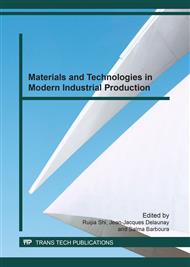p.3
p.8
p.12
p.17
p.22
p.27
p.32
p.36
Comparison of Layer-Forming and Bromine-Doping Methods of Pentacene Layer in Solid-State Dye-Sensitized Solar Cell
Abstract:
For organic solar cells (OSC) such as dye-sensitized cell (DSSC) to compete with silicon-based cells in terms of stability, there is a need to further improve components which causes degradation. To answer the stability issue with liquid electrolyte, solid state dye-sensitized solar cell (SS-DSSC) was introduced. SS-DSSC promises performance consistency due to less power degradation compared to standard DSSC that uses liquid-based electrolyte. Pentacene (PEN), a semiconductor usually used on field-effect transistors is a material that has a higher hole and electron mobility when compared to amorphous silicon and also has a band gap suitable for solar energy conversion. In this study, PEN used as hole transporting layer in SS-DSSC was fabricated through spin coating and heating using a precursor and through vapour transport using powder. The PEN samples were then doped with bromine through different methods - immersion and vaporization. Characterization of the PEN samples through X-ray Diffraction, Energy Dispersive X-ray Fluorescence, and Atomic Force Microscopy reveal orthorhombic, thin film, and crystalline bulk phases present on different fabricated PEN samples as well as confirmed successful doping. Furthermore, the light harvesting parameters are analysed through SolarTM Light LS1000 Solar Simulator (AM 1.5, 100 mW/cm2) which confirm correlation between the increased efficiency, PEN layer growing methods, and bromine doping methods.
Info:
Periodical:
Pages:
17-21
Citation:
Online since:
March 2017
Authors:
Price:
Сopyright:
© 2017 Trans Tech Publications Ltd. All Rights Reserved
Share:
Citation:


